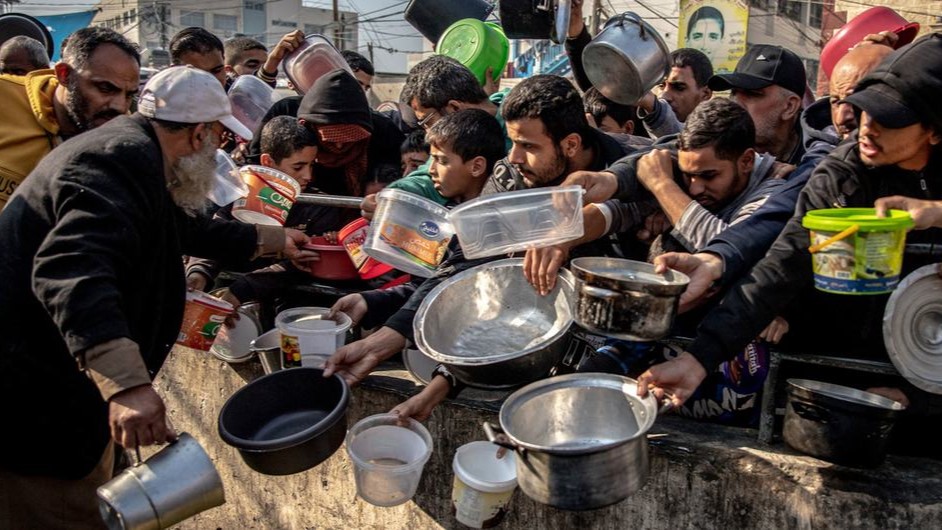Original article republished from peoples dispatch under a Creative Commons Attribution-ShareAlike 4.0 (CC BY-SA) license.

A new report found that that over 15% of children under the age of 2 in northern Gaza are acutely malnourished, with 3% of them suffering from wasting. The World Food Programme has warned that without a ceasefire, a famine may ravage Gaza by May
Nutrition indicators among children in Gaza have been declining at an unprecedented rate since the beginning of Israeli attacks on October 7, 2023. Without a ceasefire, there will be a famine ravaging through the region by May, warned the World Food Programme (WFP).
In a new report based on data collected by the World Health Organization (WHO) and UNICEF, the Global Nutrition Cluster found that over 15% of children under the age of 2 in northern Gaza are acutely malnourished, with 3% of them suffering from wasting.
The numbers in the southern regions, including Rafah, where most of Gaza’s population has been displaced to, are somewhat lower, yet still represent a massive increase compared to the situation before October 7. The report indicates that by January, 5% of under-2-year-olds in Rafah were acutely malnourished. Previously, less than 1% of children younger than 5 experienced such circumstances across the entire Strip.
The extent of malnourishment is creating the perfect conditions for the spread of communicable diseases, which could drive the devastating number of children killed by Israeli attacks even higher. As most children can only consume food of low variety, their bodies become more vulnerable to the effects of otherwise treatable conditions, like diarrhea. Additionally, the lack of clean potable water, affecting all households in Gaza, further decreases the chances of treating these conditions.
Children are not the only group affected by the lack of food. Their parents, including pregnant mothers, are choosing to forgo meals to feed their children. Approximately 95% of pregnant and breastfeeding women in Gaza are not getting enough to eat. If they have access to food, it is of low nutritional value, adding to the pre-existing burden of anemia and undermining maternal health.
The WFP has documented much of this situation but stopped delivering aid to northern Gaza as the occupying forces did not ensure conditions for safe delivery. The aid entering southern regions of Gaza remains only a small fraction of what is needed, and the effects of malnutrition are exacerbated by the destruction of the health infrastructure.
Read more: Israel intensifies assault on healthcare in Gaza. Only 11 hospitals are partially functioning
No hospital or health center is spared in this process, and attacks have also been noted against civilian infrastructure where health workers and their families are seeking shelter. In one of the most recent attacks of this kind, the Israeli Occupying Forces (IOF) targeted a house where 64 Doctors Without Borders (MSF) staff members and their families were staying. The building was clearly marked with an MSF flag, and the IOF were informed of their presence, yet they attacked the house, killing several people inside.
According to MSF, the IOF’s action “shows a complete disregard for human life and a lack of respect for the medical mission. This makes it almost impossible to sustain medical humanitarian activities in Gaza.”
As the IOF persists in its attacks on hospitals, not only the shelling but also the evacuation orders and sieges further jeopardize the health of people who are already sick or wounded. Commenting on recent cases of hospital evacuation in Gaza, Guillemette Thomas from MSF pointed out that patients were forced to leave on foot, in wheelchairs, or even rolled in hospital beds, despite being in no condition to be moved.
Their treatment increases the risk of infection and lowers the chances of recovery, Thomas stated. “This can be extremely dangerous for them. When someone with a severely fractured leg starts to walk, it compromises their possibility to regain mobility and can have life-threatening consequences.”
Even after most patients, medical staff, and forcibly displaced people are evacuated from the hospitals, Israeli forces continue to besiege them. On February 22, after a full month of besieging and targeting Al-Amal Hospital in Khan Younis, the IOF damaged the hospital’s communication devices, which are used by the Palestine Red Crescent Society (PRCS) for locating and dispatching teams. This is only one in a series of IOF attacks that hit the PRCS, following the kidnapping of several staff members, destroying ambulance vehicles dispatched to rescue children, and raids on Al-Amal, which left behind damaged medical equipment and vehicles.
Read more: Palestinian health workers kidnapped by Israel subjected to torture and humiliation
The situation is far from better in Nasser Hospital. While the WHO and other organizations were finally able to reach the complex to evacuate one part of the patients who had stayed behind following a violent incursion into the buildings by the IOF, over 100 patients who cannot move and about a dozen medical staff providing them care still remain behind.
The UN health agency was granted permission to enter Nasser Hospital only earlier this week, after several attempts were blocked by the Israeli forces. “Prior to the missions, WHO received two consecutive denials to access the hospital for medical assessment, causing delays in urgently needed patient referral. Reportedly, at least five patients died in the Intensive Care Unit before any missions or transfers were possible,” the organization said in a statement.
Upon their return from Nasser, WHO staff said the destruction was indescribable. “Gaza has become a death zone,” said WHO Director-General Tedros Adhanom Ghebreyesus.
Original article republished from peoples dispatch under a Creative Commons Attribution-ShareAlike 4.0 (CC BY-SA) license.